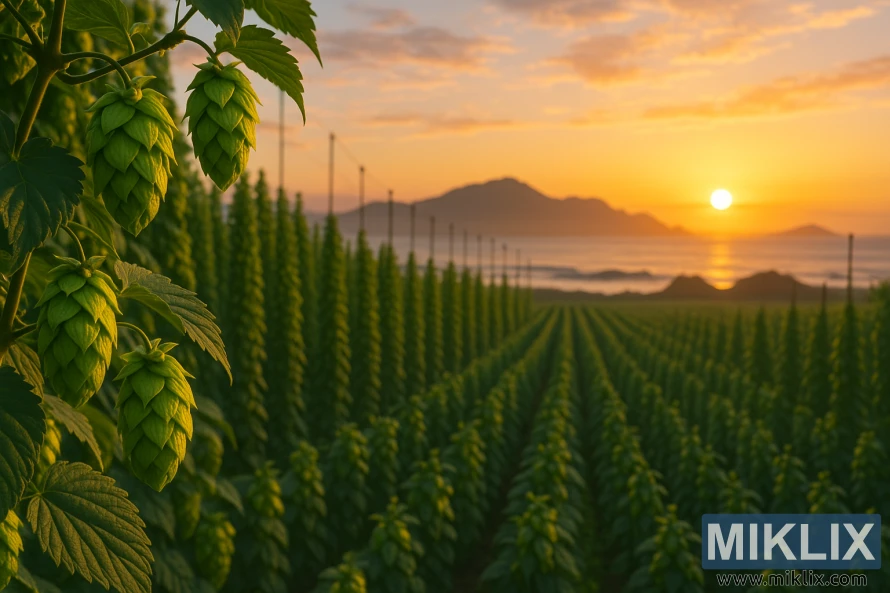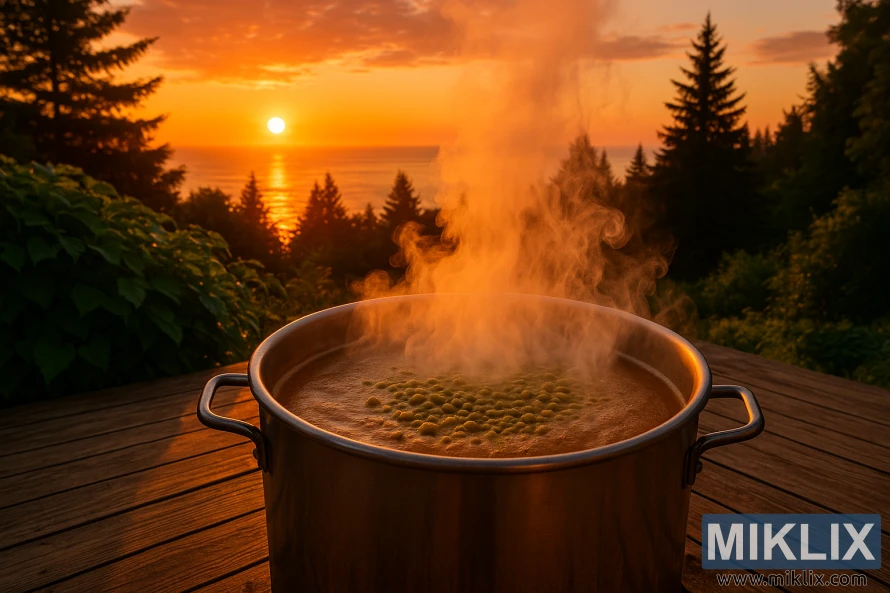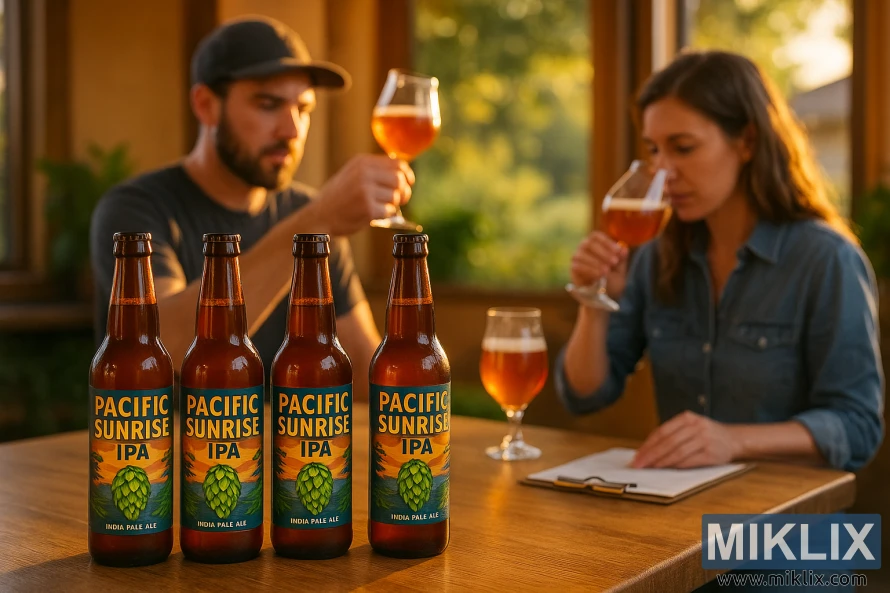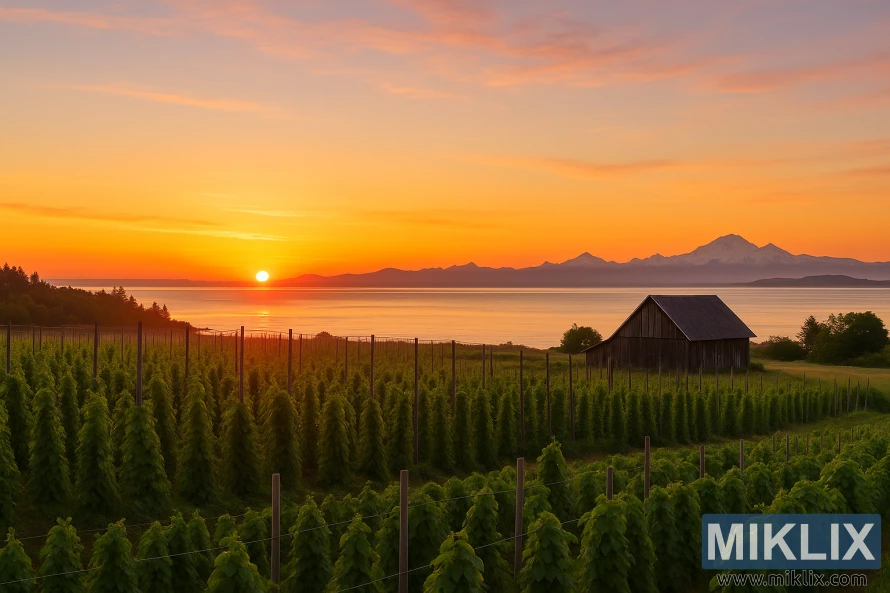Hops in Beer Brewing: Pacific Sunrise
Published: September 22, 2025 at 9:04:50 PM UTC
Pacific Sunrise Hops, bred in New Zealand, have become known for their reliable bittering and vibrant, tropical fruit notes. This introduction sets the stage for what you'll discover about Pacific Sunrise brewing. You'll learn about its origins, chemical makeup, ideal uses, pairing suggestions, recipe ideas, and availability for both homebrewers and commercial brewers. The hop's citrus and stone-fruit flavors complement pale ales, IPAs, and experimental pale lagers. This Pacific Sunrise hop guide will provide practical advice on how to use it.

Key Takeaways
- Pacific Sunrise Hops combine solid bittering capacity with tropical-citrus aroma suitable for many ale styles.
- Origins among New Zealand hops influence their fruity profile and modern craft appeal.
- Use kettle additions for balanced bitterness and whirlpool or dry-hop for aromatic lift.
- This Pacific Sunrise hop guide offers recipe and pairing ideas for clear results at home or in a commercial brewery.
- Storage, freshness, and handling are critical to preserve the variety's delicate aromatics.
What Are Pacific Sunrise Hops and Their Origin
Pacific Sunrise hops were bred in New Zealand and introduced by HortResearch in 2000. The breeding aimed to create a hop with strong bittering properties and a clean flavor. This was a result of focused efforts in New Zealand.
The Pacific Sunrise hops have a unique lineage. They are a mix of various hop varieties, including Late Cluster, Fuggle, and others from Europe and New Zealand. Their female side comes from California Cluster and Fuggle.
NZ hops Pacific Sunrise are mainly grown in New Zealand. They are listed under NZ Hops Ltd. They are harvested in late summer in the Southern Hemisphere.
The harvest for Pacific Sunrise hops begins in late February or March. It lasts until early April. This period allows brewers to get fresh whole-cone and pellet hops for the new season.
- Purpose: developed chiefly for bittering, not just for aroma.
- Formats: commonly offered as whole cones and pellets from multiple suppliers.
- Availability: crops and prices vary by supplier and harvest year; lupulin-concentrate formats are not widely available.
Brewers interested in NZ hops Pacific Sunrise can expect a reliable bittering hop. Its history and origin highlight its importance in both commercial and craft brewing. Its consistent alpha acid performance is key.
Flavor and Aroma Profile of Pacific Sunrise Hops
Pacific Sunrise flavor bursts with citrus notes. Lemon zest and bright orange cut through malt sweetness. This is accompanied by ripe tropical fruit, making beers juicy and appealing.
Mango and melon dominate the tropical elements. Passionfruit and lychee impressions are also present in SMaSH trials. These tropical hops add a layered fruit character without overpowering the beer.
Stone fruit and jammy sweetness form the midrange. Plummy and raisin-like hints add depth, with a light caramel sheen. Some small-batch evaluations noted a delicate butterscotch or caramel creaminess in the finish.
Background notes include piney and woodsy tones. A hint of hay and subtle herbal accents round out the profile. When used late in the boil or in whirlpool, Pacific Sunrise aroma reveals a pleasant resinous edge.
Despite its aromatic strengths, this hop often serves well for bittering. It brings firm bitterness while contributing fruity and citrus aromatics when added late. Brewers balance bitterness and aroma to showcase the hop’s best traits.
Mouthfeel impressions vary from creamy to slightly pithy. Citrus pith can appear in the aftertaste, giving a dry, refreshing snap. The overall profile reads as woody, lemon, orange, mango, melon, floral, and tropical with a touch of stone fruit.
- Core notes: lemon, orange, mango, melon
- Secondary hints: pine, hay, herbs, plum
- Texture cues: creamy caramel, plummy essence, citrus pith
Brewing Values and Chemical Composition
Pacific Sunrise alpha acids typically range from 12.5% to 14.5%, averaging around 13.5%. Some reports extend this range to 11.1% to 17.5%. This makes Pacific Sunrise a top choice for those seeking strong bitterness without excessive hop weight.
Beta acids usually hover between 5–7%, averaging 6%. The alpha-beta ratio is often around 2:1 to 3:1, with a common 2:1. The co-humulone, making up 27–30% of alpha acids, averages 28.5%. This contributes to a cleaner, smoother bitterness compared to other high-alpha hops.
Pacific Sunrise oils average about 2 mL per 100 g, typically between 1.5 and 2.5 mL/100 g. These oils are key for aroma and flavor, as they are volatile and degrade with prolonged boil times.
- Myrcene: roughly 45–55% of total oil, near 50%, giving resinous, citrus, and fruity notes.
- Humulene: about 20–24%, around 22%, supplying woody and spicy characters.
- Caryophyllene: near 6–8%, roughly 7%, adding peppery and herbal accents.
- Farnesene: minimal, around 0–1% (≈0.5%), providing faint green or floral top notes.
- Other components (β-pinene, linalool, geraniol, selinene): together 12–29%, bringing additional complexity.
Understanding the hop composition of Pacific Sunrise aids in planning additions. Use early additions for alpha acid extraction, leveraging the high AA for IBUs.
Reserve most Pacific Sunrise oils for late additions, whirlpool, or dry hopping. This preserves citrus and tropical aromas, along with woody-pine nuances. These aromas benefit from minimal heat and short contact times.
How to Use Pacific Sunrise Hops in the Brew Kettle
Pacific Sunrise is celebrated for its high alpha acids, making it ideal for bittering. Add it early in the boil to ensure efficient isomerization and a solid IBU backbone. Use alpha values of 12.5–14.5% to accurately calculate additions for your desired bitterness.
Adjustments for crop variance and supplier alpha acid numbers are essential for consistent bitterness. Many brewers set their main bittering addition at 60 minutes. They then fine-tune hop utilization Pacific Sunrise in software or formulas to match mash and kettle conditions.
Late-kettle additions also offer value. A 5–10 minute addition or a flameout/whirlpool charge can introduce citrus, tropical, and woody notes. These are driven by myrcene and humulene. Keep these additions brief to protect volatile oils and avoid excess bitterness from prolonged heat.
Utilize a hop stand or whirlpool around 180°F (82°C) for 10–20 minutes. This method pulls flavor and aroma without excessive isomerized alpha acids. It's effective in SMaSH trials where a single hop needs both bittering strength and aromatic lift.
- Measure alpha acids and calculate IBUs before brewing.
- Place primary bittering at the start of the 60-minute boil.
- Add small late-kettle amounts for aroma at 5–10 minutes or flameout.
- Use a 10–20 minute whirlpool at ~180°F (82°C) to maximize aroma with controlled isomerization.
Consult supplier dosage guides for practical dosing ranges. Many craft recipes pair Pacific Sunrise boil additions with softer aroma hops later. This creates a clean backbone while other varieties add bright top notes.
Track hop utilization Pacific Sunrise by recording boil vigor, wort volume, and kettle geometry. These variables affect effective IBUs. Keeping detailed notes helps recreate balance in future brews and improves timing and dosing of Pacific Sunrise boil additions.

Dry Hopping and Whirlpool Use for Aroma Development
Implement a whirlpool Pacific Sunrise technique by cooling the wort to about 180°F (82°C). Hold it for roughly 10 minutes. This hop stand method preserves volatile oils. It enhances the extraction of myrcene and humulene, revealing citrus, tropical, and woody notes.
For dry hopping, small additions of Pacific Sunrise can unveil surprising tropical and stone-fruit nuances. Despite its reputation for bittering, modest dry-hop rates introduce creamy and fruity facets. These were evident in SMaSH trials.
Dosage and timing are critical. A practical example from a SMaSH trial used 7 g additions at late boil, hop stand, and dry hop for a 2 lb (0.9 kg) batch. Scale these amounts according to your batch size and aroma goals.
No commercial lupulin powder or Cryo equivalent exists for this variety. So, plan on using whole leaf or pellet formats. This limits concentrated oil-only additions. Whirlpool and Pacific Sunrise dry hop techniques are the best for extracting aroma oils from the hops.
Expect complex flavor outcomes when focusing on aroma extraction. Notes of wet raisin, plum, and lychee-like character emerge. A tropical salad impression is also present, with citrus pith balancing creamy-sweet fruit in the finished beer.
- Whirlpool: aim for 10 minutes at ~180°F for clean oil capture.
- Dry hop: use small, late additions to highlight tropical and stone fruits.
- Format: choose pellets or whole leaf; adjust contact time to avoid vegetal character.
Beer Styles That Benefit from Pacific Sunrise Hops
Pacific Sunrise is versatile across various beer styles. Its high alpha acid makes it ideal for bittering in clean, malt-forward lagers. Hop databases and brewer notes highlight its use in lagers for a crisp backbone and subtle tropical lift.
In pale ales and hop-forward ales, Pacific Sunrise adds tropical-citrus and woody notes. It pairs well with brighter aroma hops like Citra, Mosaic, Nelson Sauvin, Motueka, and Riwaka. This combination builds layered complexity without overpowering the beer.
For IPAs, Pacific Sunrise serves as a solid bittering base. When combined with late additions and dry hops from vibrant varieties, it shapes bitterness while allowing bold aromatics to shine.
- SMaSH trials: test Pacific Sunrise alone to understand its bittering and fruity-woody profile.
- Pale ales: add a touch for tropical lift that complements malt sweetness.
- IPAs: use for bittering and then layer brighter aroma hops for top-end character.
- Lagers: employ Pacific Sunrise in lagers to provide clean bitterness and subtle fruit notes.
Many brewers use Pacific Sunrise as a background hop, not a single-variety aroma star. In this role, it delivers rounded complexity and efficient IBUs. This allows complementary hops to define the top-note character.
When building recipes, start with conservative late-hop rates and adjust based on trial SMaSH batches. These beers showcase Pacific Sunrise's impact on bitterness, aroma interaction, and its balance in both clean lagers and bold ales.

Pairing Pacific Sunrise Hops with Other Hops and Yeasts
Pacific Sunrise pairs well with bright, tropical hops like Citra and Mosaic. Use it as a bittering backbone. Then, add Citra, Mosaic, or Nelson Sauvin for citrus, mango, and stone-fruit notes.
For a New Zealand twist, combine Pacific Sunrise with Motueka or Riwaka. Motueka adds lime and clean citrus, while Riwaka brings resinous, gooseberry-like flavors. Magnum is great for early-boil additions, providing firm IBUs without altering flavor.
Choosing the right yeast is critical. Opt for neutral strains like SafAle US-05, Wyeast 1056, or White Labs WLP001 for clean hop expression. These yeast pairings Pacific Sunrise allow bitterness and subtle aromatics to shine.
For fruitier flavors, select a mildly ester-producing English ale yeast. Use it sparingly to avoid overpowering the delicate citrus and tropical notes. Balance is essential when planning yeast pairings Pacific Sunrise.
Practical balancing tips:
- Use Pacific Sunrise as a mid-to-early kettle bittering hop, then add aromatic hops late in the boil or in whirlpool for lifted top-notes.
- Keep malt sweetness moderate to support jammy and stone-fruit signals without making the beer cloying.
- Dry hop with a blend—small amounts of Citra or Nelson Sauvin accentuate aroma without overpowering Pacific Sunrise combinations.
Try a simple experiment:
- Bitter with Magnum or Pacific Sunrise at 60 minutes for clean bitterness.
- Whirlpool with Pacific Sunrise plus 25% Mosaic and 25% Nelson Sauvin for fruit complexity.
- Ferment on US-05 for clarity, or test WLP001 for a touch more roundness.
These hop pairings Pacific Sunrise and yeast choices offer flexible templates. They allow brewers to create bright, citrus-driven ales or richer, stone-fruit-forward saisons by adjusting yeast and hop ratios.
Recipe Ideas and SMaSH Experimentation
Embark on a Pacific Sunrise SMaSH journey to grasp the essence of hop character. Begin with a single malt, such as Rahr 2-row, and US-05 yeast. Heat the mash to 150°F (66°C) for 60 minutes. Next, boil for 60 minutes, adding hops in small stages. Finish by sampling the aroma.
In one experiment, 2 lb (0.9 kg) of Rahr 2-row was used. At 10 minutes before the end, 7 g of hops were added. A hop stand at 180°F (82°C) for 10 minutes with 14 g followed. The beer was then chilled and fermented with US-05 yeast. On day three, 7 g of hops were dry hopped. The result was a beer with notes of wet raisin, canned lychee, and creamy caramel.
For a single hop Pacific Sunrise, use it as the bittering backbone. Pair it with Citra or Mosaic for a bright, citrusy lift. This combination works well in pale ales and IPAs, where Pacific Sunrise provides bitterness and the aroma hops add tropical and citrus notes.
- SMaSH base: 2-row malt, mash 150°F (66°C), 60 minutes.
- Bittering: calculate IBUs using AA% (12–14% typical) and scale hops to batch size.
- Late aroma: small staged additions at 10–5 minutes keep delicate esters intact.
When testing single hop Pacific Sunrise, keep batch sizes small and document every step. Experiment with hop-stand durations between 5 and 20 minutes to observe changes in floral and fruity esters. Try dry hopping at different stages of fermentation to compare aroma retention.
- Small-batch SMaSH—learn core flavors without masking blends.
- Pacific Sunrise as bittering hop—use AA to calculate doses, then add aroma hops later.
- Blend trials—combine Pacific Sunrise with Citra or Mosaic for contrast.
For dosage guidance, scale SMaSH amounts proportionally to your batch size. Use modest weights for aroma and dry hop additions to avoid overpowering flavors. Record temperatures, timings, and weights to confidently repeat successful Pacific Sunrise recipes.

Substitutions and Finding Alternatives to Pacific Sunrise
When Pacific Sunrise hops are out of stock, brewers look for substitutes that match their bittering and aroma roles. First, determine if you need a bittering or aromatic substitute. For bittering, match the alpha acid content. For aroma, find hops that match the citrus, tropical, pine, or woody notes you desire.
Pacific Gem is often recommended as a substitute for Pacific Sunrise, given its similar aroma profile. For a clean bittering backbone, Magnum is a good choice. For bright, tropical flavors, Citra or Mosaic can add aromatic lift but may require adjustments to alpha acid content.
Use hop analysis tools to compare the alpha acid and oil composition of different hops. Examine myrcene, humulene, and caryophyllene levels to predict their impact. Keep in mind that crop year variability can affect intensity, so always check lab data when available.
- Match alpha acid for bittering roles to maintain IBUs.
- Match sensory descriptors—citrus, tropical, pine, woody—for aroma swaps.
- Adjust rates when using concentrated cryo or lupulin products, as Pacific Sunrise lacks a cryo form.
Practical substitution tips include adjusting the weight of hops to hit the target alpha acid content. Consider splitting additions between whirlpool and dry-hop to balance extraction. Always taste and keep detailed notes. Tracking changes helps refine future substitutions.
Data-driven comparisons make finding alternative hops to Pacific Sunrise easier and more predictable. By combining a neutral bittering hop with a bold aromatic variety, you can replicate the layered character of Pacific Sunrise without losing balance.
Availability, Formats, and Purchasing Tips
Pacific Sunrise hops are available from top suppliers like Yakima Valley Hops and major online retailers. The availability changes with the harvest cycles. So, it's wise to check the inventory early if you're planning a seasonal brew.
The hops are mainly sold as whole leaf or Pacific Sunrise pellets. Homebrewers often prefer pellets for their convenience and ease of measurement. Cryo or lupulin-concentrated formats are not commonly found for this variety.
When purchasing Pacific Sunrise hops, ensure you check the harvest year and alpha acid percentage. These factors influence bitterness, aroma, and consistency between batches.
For initial batches, consider starting with small quantities for a SMaSH test. Many brewers buy a single ounce or 100 g of Pacific Sunrise pellets to gauge the aroma impact.
- Compare prices across retailers and note package sizes.
- Confirm shipping timelines from New Zealand growers if ordering outside Australasia.
- Prefer suppliers with lot tracking and clear crop data for better repeatability.
Pacific Sunrise availability tightens after the harvest, which occurs from late February to April in New Zealand. Plan your orders well in advance to account for shipping and customs when importing to the United States.
Keep track of alpha acid variance and harvest notes from suppliers. This helps you adjust hop additions and ensures a reliable source for future purchases.

Storage, Freshness, and Handling for Best Results
Hop oils in Pacific Sunrise are delicate. To preserve aroma and alpha acids, store Pacific Sunrise hops in a cold environment. Ensure they are away from oxygen and light.
Opt for a hop vacuum pack or nitrogen-flushed foil bag from the supplier. Store them in the refrigerator at 0–4°C for short-term use. For longer storage, freeze at −18°C to slow down the loss of volatile oils.
When opening a package, act swiftly. Reduce exposure to air, light, and heat as much as possible. Weigh batches on a chilled surface. Then, reseal unused hops in a hop vacuum pack or an airtight container with oxygen absorbers.
- Pellet hops generally have better storage stability and utilization compared to whole-leaf hops.
- Whole-leaf hops also require cold, oxygen-limited storage to maintain their flavor.
- Check the harvest year and alpha acid values on the label. Adjust hop additions if the hop shows signs of aging.
Expect a gradual decrease in hop freshness Pacific Sunrise over time. Monitor the aroma before use. Increase late or dry-hop additions slightly when using older stock.
Regular stock rotation is key to maintaining consistent beer quality. Label packages with the date received. Use the oldest, highest-quality hops first to protect your recipes and preserve the desired character.
Common Brewing Challenges and How to Solve Them
Pacific Sunrise brewing issues often stem from natural variability in alpha acids and oil content. Always check the supplier label for AA% before brewing. Recalculate IBUs if values differ from your recipe. Keep small batches for sensory comparison.
Subdued aroma is common when Pacific Sunrise is used alone in late additions. Pair it with high-aroma hops like Citra, Mosaic, or Nelson Sauvin. Increase dry-hop rates modestly or use a hop stand or lower-temperature whirlpool to protect fragile volatiles. These methods help preserve bright citrus and stone-fruit notes.
Woody or hay-like notes can be distracting in some lots. Reduce late or dry-hop quantities to soften these tones. Blend Pacific Sunrise with fruit-forward varieties to mask or balance pine and vegetal character without losing complexity.
Lack of lupulin or cryogenic products can limit aroma punch. If cryo Pacific Sunrise is unavailable, raise late and dry-hop rates slightly. Consider using cryo versions of pairing hops to boost perceived intensity while keeping vegetative extraction low.
Perceived bitterness that feels sharp often ties to mash profile and mouthfeel. Adjust mash temperature to alter fermentability. A higher mash temp yields a fuller body that rounds bitterness. Use smoothing malts like Vienna or Munich or add more late hops to mellow harsh edges. These steps help in fixing hop bitterness Pacific Sunrise without stripping aroma.
- Check AA% and recalc IBUs for variable crops.
- Pair with Citra, Mosaic, or Nelson Sauvin and modestly increase dry-hop for aroma.
- Cut late/dry-hop amounts or blend with fruit-forward hops to tame woody notes.
- Raise late/dry-hop rates if lupulin forms are missing; use cryo on paired hops.
- Adjust mash temp and malt bill to smooth perceived bitterness while preserving balance.
Use sensory benchmarking and journal each batch. This practical routine reduces Pacific Sunrise brewing issues over time and guides targeted adjustments. Testing small changes keeps your process nimble and improves results batch to batch.
Case Studies and Tasting Notes from Brewers
Small-batch SMaSH trials offer practical insights. A focused brew used Rahr 2-row, mashed at 150°F (66°C), with a 60-minute boil and US-05 yeast. Hop additions were 7 g at 10 minutes left, 14 g at a 180°F hop stand for 10 minutes, and a 7 g dry hop on day three. These Pacific Sunrise SMaSH notes reveal wet raisin, wet plum, and canned lychee on the nose.
Tasters noted a creamy caramel midpalate and a plummy sweetness that lingered. Some detected a faint tropical salad character beneath the stone fruit. The finish carried a citrus pith aftertaste with a subtle butterscotch-like quality.
Multiple reports from Pacific Sunrise brewers highlight sweet fruit, citrus, and woody aromatics. They often use this hop as a background layer to enhance brighter varieties. This trend is reflected in homebrew recipe datasets, where Pacific Sunrise frequently pairs with Citra, Nelson Sauvin, Motueka, Riwaka, Mosaic, and Magnum.
Flavor outcomes commonly include creamy sweetness and a plummy profile with subdued tropical notes. The citrus pith finish adds a bright edge, preventing cloying sweetness. These Pacific Sunrise tasting notes guide brewers in pairing and timing choices.
- SMaSH takeaway: gentle late additions and a short hop stand preserved delicate stone fruit and lychee facets.
- Blend strategy: use Pacific Sunrise as a supporting hop to add depth behind high-impact hops like Mosaic or Citra.
- Dry-hop timing: early dry hop (day three) kept volatile esters vivid without harsh green character.
Community trends reveal over sixty-four recipes experimenting with Pacific Sunrise, providing consistent real-world feedback. Pacific Sunrise brewer reports and SMaSH experiments together offer a practical guide for using this hop in ales, saisons, and hybrid styles.
Conclusion
Pacific Sunrise summary: This hop from New Zealand boasts a high alpha acid range, roughly 12–14%. It's a strong bittering choice. Yet, it offers subtle tropical, citrus, and woody aromas when used late or in dry-hop additions. It's ideal for brewers looking for a reliable bittering backbone that adds complexity. Pacific Sunrise works well across lagers and ales.
Should I use Pacific Sunrise? First, check the supplier's alpha-acid assay and the hop's harvest year. Store hops cold and oxygen-free to preserve freshness. Use modest whirlpool or hop-stand times and restrained dry-hop rates to unlock aroma without overpowering the beer. Pair Pacific Sunrise with brighter aroma hops like Citra, Mosaic, Nelson Sauvin, Motueka, or Riwaka. Consider clean, neutral yeasts like Safale US-05 or Wyeast 1056/WLP001 to let the hop character shine.
Practical takeaway and Pacific Sunrise hops conclusion: Use it as a dual-purpose hop—efficient for bittering, and secondarily for subtle fruity and woody notes. Run small SMaSH trials to see how a given crop year expresses itself before scaling up. This approach gives brewers confidence to deploy Pacific Sunrise in production recipes with predictable results.
Further Reading
If you enjoyed this post, you may also like these suggestions:
